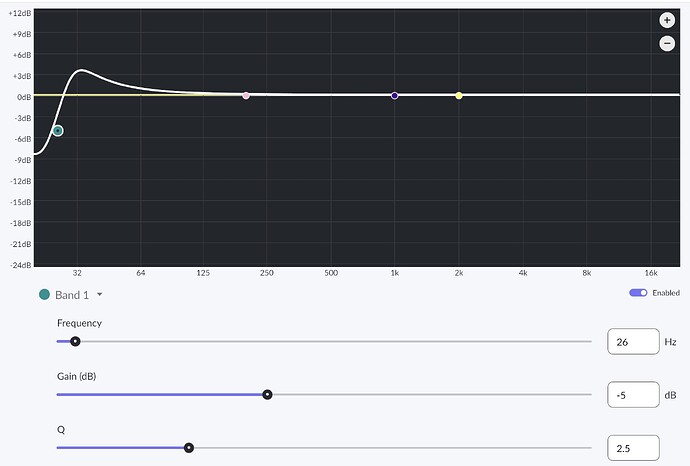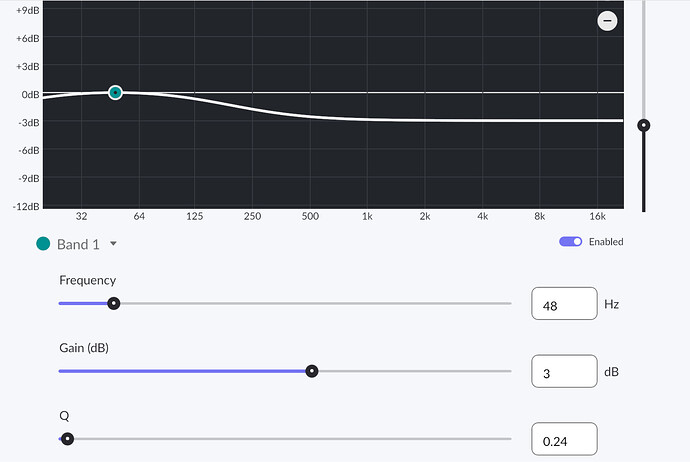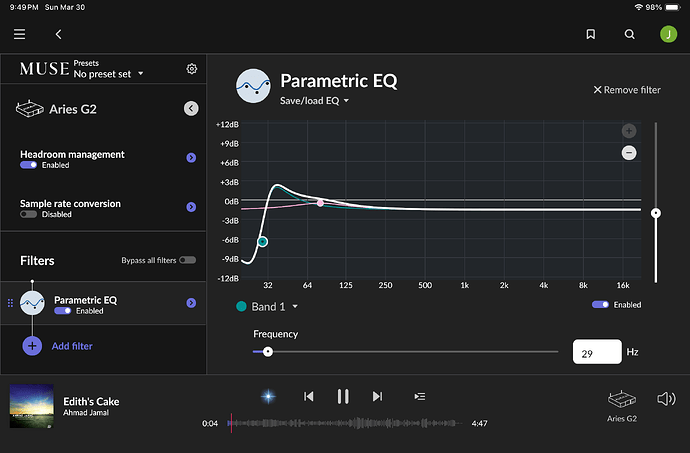Please post some of your favorite Parametric EQ settings for adding a bit of bass. I am running the Buchardt P300’s and would like to awaken them a bit. Thanks!
this should be interesting … I played s bit but not to my taste…ended up picking up a SVS Micro Sub which is a good match to my Buchardt … Im trying to tweak the bloating in the mid bass …
Anxious to see the Parametric settings other users have
I prefer a low shelf filter with a higher Q (1.5-4) and attenuation setting, i.e. -2dB…-5 dB. It serves both as a bass emphasis to extend the speakers lower end as well as a subsonic protecting both the digital and the transducer system from overloading.
You have to know where your lower end capabilities of the speakers are ending and in which region they have a tendency to sound slightly booming (usually the resonance frequency of the vented system if they are not closed box designs).
I have tried 3 different subs with my Buchardt’s. Polk, Emotiva and Sony. I did not like any of them. Tried a Lokius. Had to get my lazy butt up every time a new track came on to adjust sound. I had one setting on the parametric EQ that I liked somewhat. Thought I would get some other ideas from the group…
Parametric EQ does somewhat of a good job … but for me in my room a sub was required for the Buchardt S400 MK II
The SVS has a very good iOS App so no getting up and really is a good match to the Buchardt … if ever you can demo one… I would be happy to share my settings…all from the app… ![]()
Would take that as a hint you might have some acoustical problems in your room either emphasizing or cancelling out certain narrow frequency bands.
Neither a subwoofer nor parametric EQ will help in this case (and an automatic room correction even less). I would recommend to have the frequency response measurement and analyze where the problem is really originating from. Repositioning of the speakers could do a great job in such cases or using several subwoofers.
I absolutely second that.
Due to the wide variability of room acoustics and speaker placement, any recommendation is a stab in the dark.
Also, trying to correct a system’s response by listening to a selection of music while tweaking settings is usually futile.
Marins way is the only way. Rooms are not all the same. I don’t need to boost bass at all I have quite too much room gain as it is. Also your lack of off bass might be a room mode causing a null which can’t be corrected for with peq. Measure the response of the room if you have an iPhone download Housecurve will give you a good idea of what’s going on for a few quid.
More Parametric EQ settings please!
I don’t have the Buchardt, but I agree with what you say. It took 6 months really to dial in both of my subs, IMO location has to be the first, then crossover & finally gain. I listen to full albums, 90% of the time I can leave the gain as it, but for some recordings I add a coupe of db via the app on my phone.
For anyone trying to dial in a sub I would recommend just using a single well recorded release with decent non overbearing bass, if you dial that in ok, you can just adjust the gain as & when needed for everything else.
Personally I would not be without subs now.
I tend to disagree here, as music is the only thing that can tell you if your PEQ settings are right, so you have to listen to music. A frequency response measurement can show you at which frequency you have the ugliest problems, but it would never tell you how to deal with them and - more importantly - if a parametric EQ is the right tool to counter it or better some room treatment.
Tweaking parametric EQs solely listening to music is possible, but very difficult and requires enormous experience if not proper education as a recording engineer.
That bears a risk that you dial in the sub in a wrong way but it is not revealed by that particular record. I prefer to have a bunch of recordings I do really know well (5 or 6) and go in circular order one after another.
According to my experience, the desire to put the gain of a sub up or down depending on the recording being played is a strong sign something is significantly wrong with either the complete acoustics of the room or the transistation between sub and satellites. In most cases you find a dip in the frequency response in this case that is not exactly at the x-over frequency but causing the sub to be psychoacoustically separated from the rest of the spectrum.
No, my subs are dialled in well, there’s nothing wrong with the sound from my listening position and I am very happy.
Usually the gain adjustment is to go up 1 or maybe 2 dB above the normal setting, something that works well for me if I listen to an album recorded with very poor bass.
My listening room is a family room, like for many people, speaker placement is determined by other factors.
I’m very happy with the result and the method I used to obtain that result.
…but later you write (with emphasis added by me) …
Tweaking parametric EQs solely listening to music is possible, but very difficult and requires enormous experience if not proper education as a recording engineer
The overwhelming majority of Roon users aren’t recording engineers, so taking measurements and correcting from there gets the job done much more quickly.
But you are free to keep twiddling your dials on a whim, of course!
so taking measurements and correcting from there gets the job done much more quickly.
Measurements are really good to quickly identify problematic frequency bands, I agree so far. How to correct them, and if a parametric EQ or repositioning speakers or room tuning is the best measure to do so, only experience and knowledge about acoustics can tell you. So you are half the way to recording engineer anyways.
After having done a measurement, many people have a tendency of not doing this very important interpretation step but rather just correcting things until the frequency response looks more or less even (or using automatic calibration or asking an online advisor who has never listened in this particular room). My experience is this leads to more problems and frustration in many cases although it might cut out the most annoying things like booming bass and aggressive treble.
To doublecheck if everything is right with your bass reproduction, I like to play several tracks containing picked double bass over a broad range of notes. That is usually revealing if there are still problematic frequency bands in terms of booming and thin (like cancelled out) after applying EQ.
But you are free to keep twiddling your dials on a whim, of course!
I am personally faster with just the dials plus my ears. When trying to find peaks and dips in the lower frequency range, playing around with sharp notch filters is also telling me something about the timing of the underlying resonances.
That is usually revealing if there are still problematic frequency bands in terms of booming and thin (like cancelled out) after applying EQ.
Isn’t that what any sensible DRC is supposed to fix in the first place? And of course if you have standing wave cancellation at a certain frequency, neither DRC/EQ nor twiddling with dials will do jack for it anyway.
There certainly are recordings where you might need to tweak the EQ to make them sound better (not necessarily more accurate though) but if you need to twiddle with dials after applying DRC, you are choosing the wrong target curve to begin with.
Agreed,
The OP would be better searching the Roon forum for “how to equalise my system”, and follow what are some very detailed guides on room correction. One can easily EQ bass to preference using one of many common target curves. I.e Harman, Toole etc.
Doesn’t take long with Housecurve app at all.
Thanks @Arindal I was messing around with a slight bottom end boost to make things more enjoyable at lower volumes. Used your low shelf settings at 29hz along with a second band 1db boost at 80hz and 1 Q.
It is very slight but it adds more body overall and more impact down low.


